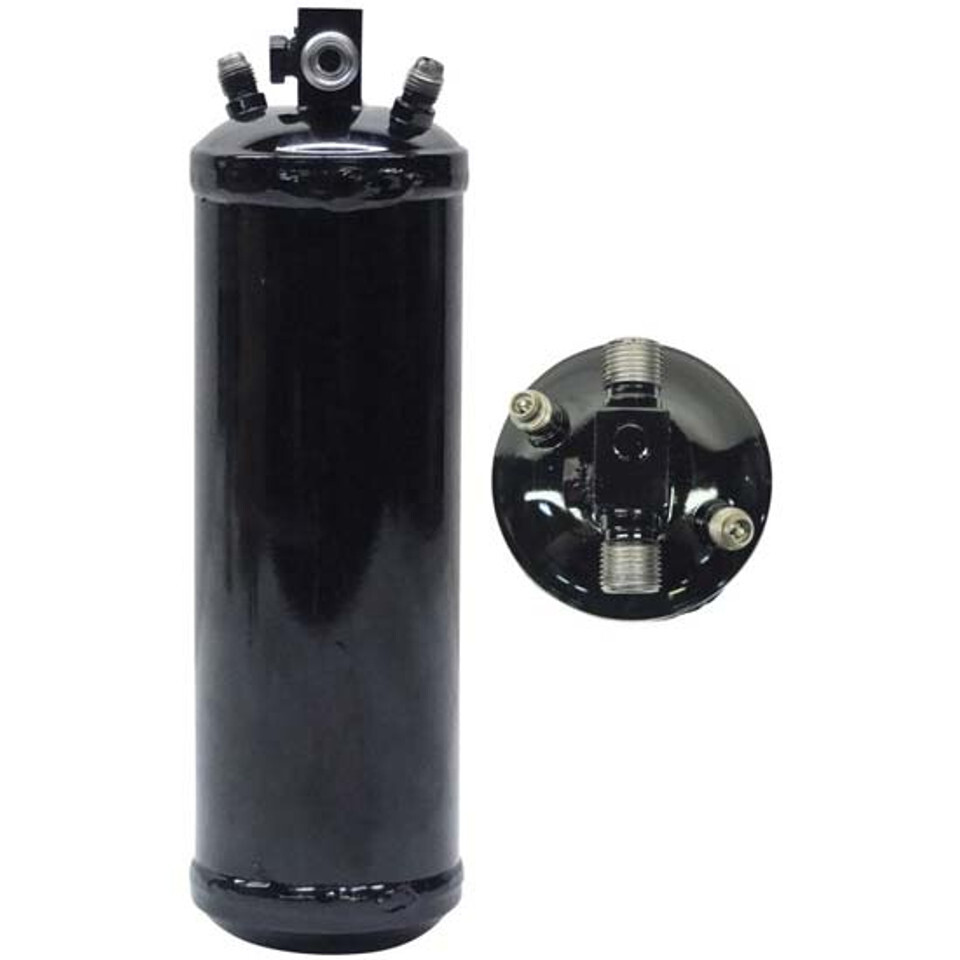How A/C Driers Work on Your Semi Truck
Ever wondered why your semi truck’s AC runs smoothly, or why it suddenly stops working? Your A/C receiver, drier, or accumulator is the unsung heroe of your commercial vehicle.
First off - Why maintain the upkeep of your air drier? If you can ensure that it works well, this part will serve as the filter and pressure valve to keep your truck’s AC system clean, well balanced, and safe.
Understanding the Role of AC Driers and Accumulators
The semi truck’s receiver-drier or accumulator play an essential role to keep your trucks’ AC system by removing moisture, filtering and capturing debris, and balancing refrigerant flow.
Here’s a breakdown:
1. Moisture Removal:
These items contain desiccant (moisture absorbing material) to remove water from the refrigerant. Moisture can destroy internal components due to rust, acid formation, ice buildup, or blockages.
2. Filtration:
Debris, from metal shavings to contaminants, are trapped to protect expensive components like the compressor
3. Refrigerant Management:
Excess refrigerant and oil is temporarily stored which prevents the system from having pressure issues and keeps a regular flow of refrigerant running. For an accumulator, this ensures that only vapor- no liquids - reach the compressor, preventing damage (since liquid can’t get compressed).
4. Lubrication Support:
By keeping the refrigerant clean, this ensures refrigerant oil can adequately lubricates the compressor’s moving parts.
Moisture and contaminants can dramatically impeded the performance of your AC system - and even hurt critical components like the compressor.
Key Differences Between Receiver Driers and Accumulators
Receiver Drier:
- Uses thermal expansion valve
- Located on the high-pressure side (after the condenser)
- Works to store clean liquid refrigerant for the thermal expansion valve
- Indirectly protects the compressor
Accumulator:
- Used with Orifice Tube
- Located on the low-pressure side (after the evaporator)
- Works to hold and vaporize refrigerant before the compressor
- Directly protects the compressor from liquid refrigerant entering into it
How AC Driers and Accumulators Work Together in Peterbilt Trucks
The refrigerant cycle in your Peterbilt truck works like a close-loop highway for refrigerant - a liquid that changes to vapor and back again.
Here’s the basic breakdown of how these parts work:
Compressor: acts like a pump, pressurizing hte refrigerant gas to get sent down the line.
Condenser: hot, high-pressure gas travels here to cool down and turn into liquid which holds the heat pulled from your cab.
Receiver Drier or Accumulator: this is where things get balanced and cleaned; the Drier filters out dirt and moisture and stores liquid refrigerantat the right level, whereas the accumulator ensures vapor moves to the compressor and protects it from liquid damage.
Expansion Valve or Orifice Tube: it's like a nozzle that sprays the liquid refrigerant int a low-pressure zone turning it into vapor that absorbs heat.
Evaporator: the mist enters the evaporator inside the ab. It sucks up heat fro mthe air and cools the cabin down; the refrigerant turns back into a gas as it absorbs heat.
Return to the Compressor: the gas flows out of the evaporator, then is pulled back in again by the compressor.
Identifying When Your Peterbilt AC Drier Needs Replacement
It’s recommended that you replace your AC Drier every 2 to 3 years or during major AC system repairs. The common signs that your Peterbilt’s AC Drier needs to be replaced:
- Weak or non-existent cooling: if the AC isn’t blowing cold air anymore, the Drier might be clogged or have excess moisture buildup - making your AC system work harder
- Unusual sounds: rattling, knocking, or buzzing near the AC line might mean a loose or broken desiccant bag in the Drier or circulating debris from a damaged interior filter
- Refrigerant or Oil Leaks: oily residue on or around the Drier might be a sign of a leak
- Cloudy or Foamy Sight Glass: some Peterbilt Driers have a sight glass to check the refrigerant’s condition; if it’s foamy, cloudy or bubbly, there’s too much air/moisture.
- Abnormal System Pressure: a worn-out Drier can cause too little or too much pressure in the AC system; if clogged, there’s high pressure, if leaking or broken, there’s low pressure.
If you’re replacing the AC compressor, condenser, or opening the AC system up for repairs, you have to replace the Drier too, since desiccant becomes ineffective after even short exposure to air.
Replacement Procedure for Peterbilt AC Driers and Accumulators
Step by step replacement can start like this:
Recover the Refrigerant:
- Use a refrigerant recovery machine to safely remove all R135a from the system.
- Don’t vent refrigeration into the air - it’s illegal and harmful.
- This step protects you, the environment, and your Peterbilt truck.
Remove the Old Drier or Accumulator:
- Disconnect the AC lines attached to the component.
- Unbolt the Drier or accumulator from its mounting bracket.
- Use the correct sockets (commonly 10mm, 13mm, and Torx E7 for Peterbilt trucks).
- Carefully remove the old O-rings from the lines.
Install the New Part:
- Lubricate new seals (might be an O-ring or stat seal) with PAG oil.
- Hand-thread the lines onto the new Drier or accumulator to avoid cross-threading.
- Secure the unit to the bracket.
- Reconnect any pressure sensors or wires that were disconnected.
Get Rid of the Moisture:
- Connect a vacuum pump to both the high and low AC ports.
- Pull a vacuum for at least 5–10 minutes (longer if humid).
- This step removes all moisture and air from the system.
- Do a vacuum hold test (close valves and watch gauges) to ensure no leaks.
Recharge the Refrigerant and Oil:
- Add back the correct amount of PAG oil, based on how much was removed earlier.
- Use manifold gauges and a refrigerant scale to precisely add R134a refrigerant.
- Start the truck and charge through the low side only.
- Watch for correct system pressures and cold air at the vents to confirm everything’s working.
Critical Safety Tips for Handling R134a Refrigerant
- Wear gloves and goggles—R134a can cause frostbite on contact.
- Always work in a well-ventilated area to avoid asphyxiation.
- Keep cylinders upright and away from heat.
- Never charge through the high side with the compressor running—it can explode.
Troubleshooting Common AC Drier and Accumulator Issues
Common AC Drier Issues
Desiccant saturation: The moisture-absorbing material inside the Drier/accumulator is used up. It can't protect the system anymore.
Internal clogging: Metal shavings, debris, or even broken desiccant can block refrigerant flow.
Corrosion: Moisture turns to acid and rusts out lines or internal parts.
Incorrect installation: Loose fittings or old O-rings can cause leaks or early failure.
Basic Troubleshooting Steps for Drivers
You don’t need to be an experienced technician to check on your AC system.
Inspect for leaks: Use a flashlight to look around fittings, hoses, and the Drier/accumulator. Greasy or oily spots = possible leak.
Listen while the AC runs: Any rattling, squealing, or knocking could point to loose parts or internal failure.
Feel the air: Weak airflow? It could be a clogged cabin air filter—cheap and easy to replace.
Check system pressure (if equipped): If you’re using a gauge set, compare readings to normal specs. Off-balance pressure can hint at a clogged or saturated Drier.
Check system age: If it’s been more than 2–3 years since your Drier/accumulator was replaced, it’s probably time—especially if the AC system has been opened recently.
If you're seeing more than one of these symptoms—or suspect liquid refrigerant is reaching the compressor—it's time to bring in a qualified tech.
Diagnosing refrigerant balance, desiccant breakdown, or compressor damage takes the right tools and know-how.
Preventative Maintenance Tips for Longevity
Two things: regular inspections and maintaining the appropriate refrigerant levels can reduce component wear and enhance the lifespan of your AC Drier, accumulator, and filter.
Frequently Asked Questions (FAQs)
What is the lifespan of a Peterbilt AC Drier?
On average, a Peterbilt AC Drier should be replaced every 2 to 3 years, or any time the AC system is opened up for repair (like compressor or condenser replacement).
The desiccant inside wears out over time or quickly becomes saturated if exposed to air. Waiting too long can lead to moisture damage, rust, or compressor failure.
Are aftermarket AC Driers brands reliable?
Aftermarket AC Driers and accumulators can be very reliable if you choose the right brand and match OEM specs.
Look for trusted names like:
- BESTfit
- UAC
- Airsource
- Truck Air
- Omega
Just make sure the size, fittings, and pressure ratings match your specific Peterbilt model.
What’s the part number for common Peterbilt truck Driers?
Here are some popular OEM and aftermarket part numbers:
Receiver Driers:
- Paccar 07-1012A – Used on 579, 567, 389, 386
- Omega 37-14006-AM – Aftermarket cross
Accumulators:
- Paccar 18-04171, F31-6063 – 3.5” x 9.25” design
- MEI 7409 – 3.0” x 9.12”
- BESTfit 3.46” x 8.97” – Aftermarket option for general Peterbilt use
Need help finding the right fit for your VIN? Just ask—happy to help you match it up!
Which Peterbilt models use receiver Driers or accumulators?
Peterbilt trucks will have one or the other, never both—depending on the type of AC system they use:
- Receiver Drier: Peterbilt 579, 567, 389, 386
- Accumulator: Peterbilt 330, 357, 375, 377, 378, 379
Shop Replacement Semi Truck AC Parts & AC Drier Parts for Your Truck
Whether you need a fulll, custom upgrade or you're after a few replacement components, you can find parts for your semi truck AC system and even your engine cooling system all in one place.
Recent Posts
-
Top 10 Semi Truck Winter Accessories for Heavy-Duty Drivers
Winter truck driving can be downright trecherous to work in, especially when you don't have the righ …21st Oct 2025 -
Haul of Fame: The Murder Pete
They call it the Murder Pete. Blacked-out, rugged, and raw, it’s a notorious big rig known for its “ …17th Oct 2025 -
How to Winterize a Semi Truck: The Complete Driver Checklist
Cold winter weather, freezing temperatures, snow-covered roads, and adverse weather conditions wreak …14th Oct 2025 -
Buyer’s Guide: Choosing the Right Semi Truck Heat Shield
A semi truck’s exhaust pipe heat shield is more than just some polished piece of metal. It’s the onl …10th Oct 2025 -
Semi Truck Winter Fronts: Useful or Outdated?
So, you're prepping your big rig for a cold and rainy season and you're thinking about winter fronts …7th Oct 2025 -
Peterbilt Clutch Parts: A No-Nonsense Guide for Owner-Operators
Your Peterbilt clutch is a small, but critical part that connects the engine power to the transmissi …3rd Oct 2025 -
Preventative Maintenance Checklist for Semi Trucks
Every truck driver knows one thing: semi-truck repairs are a nightmare for the pocketbook. Sticking …30th Sep 2025 -
Semi Truck Buying Guide: Questions to Ask Before Investing in a Rig
Choosing to invest your hard-earned dollars into a class 8 big rig is a massive decision. And if you …26th Sep 2025 -
Peterbilt Truck Speed Sensors: Everything You Need to Know
You're driving at 70 mph, but your dash says 0. Each shift jerks you forward and the cruise control …23rd Sep 2025 -
Buyers Guide to Aftermarket Air Breather Panels
Decorative light panels are an outstanding way to start personalizing your truck. Air breather panel …19th Sep 2025














